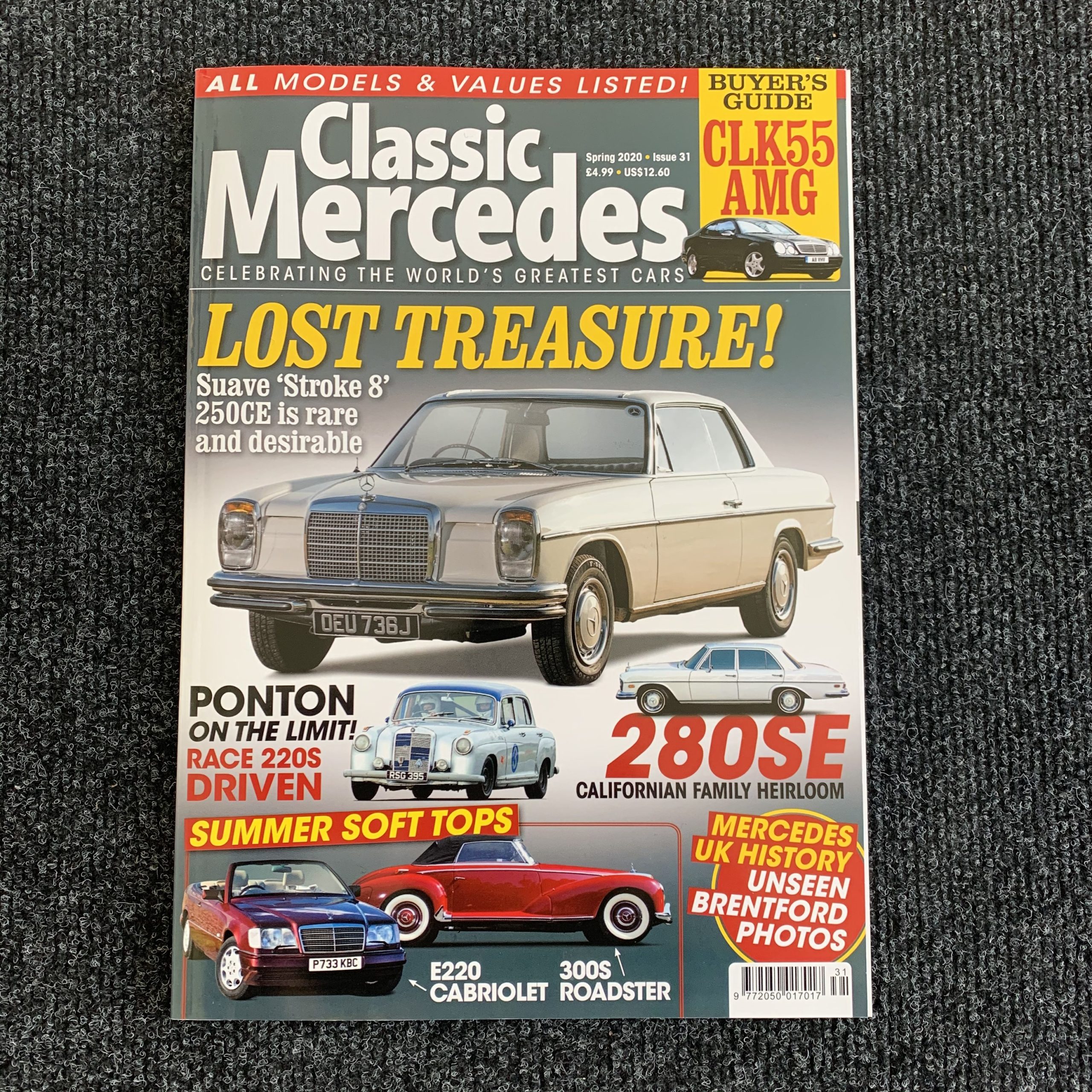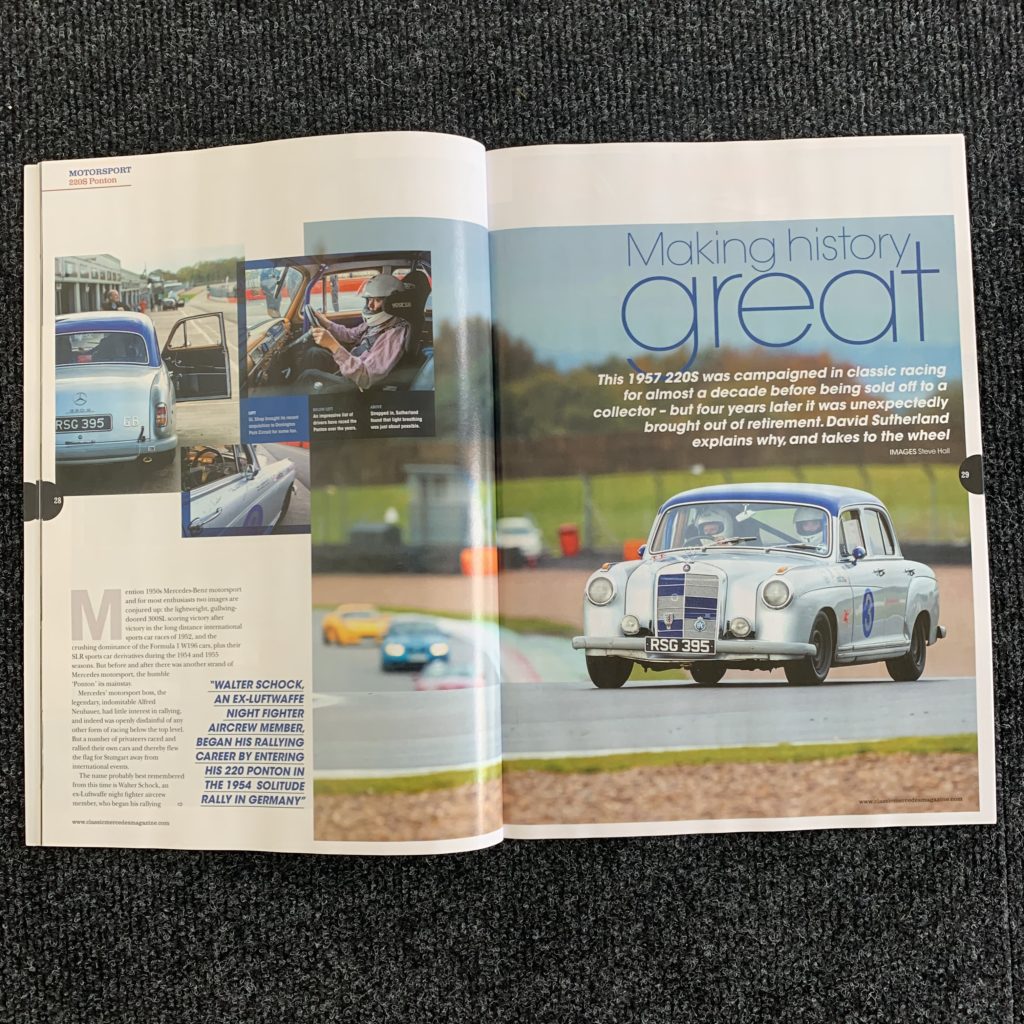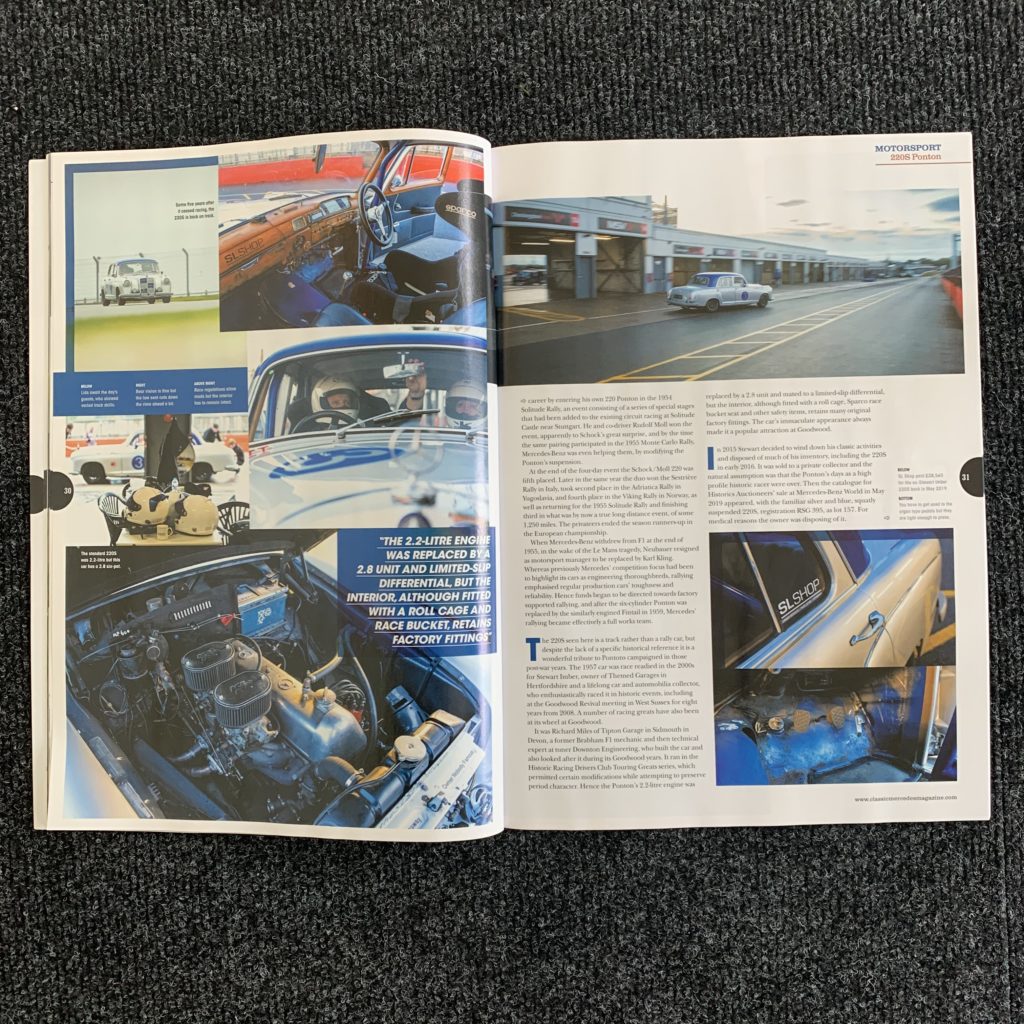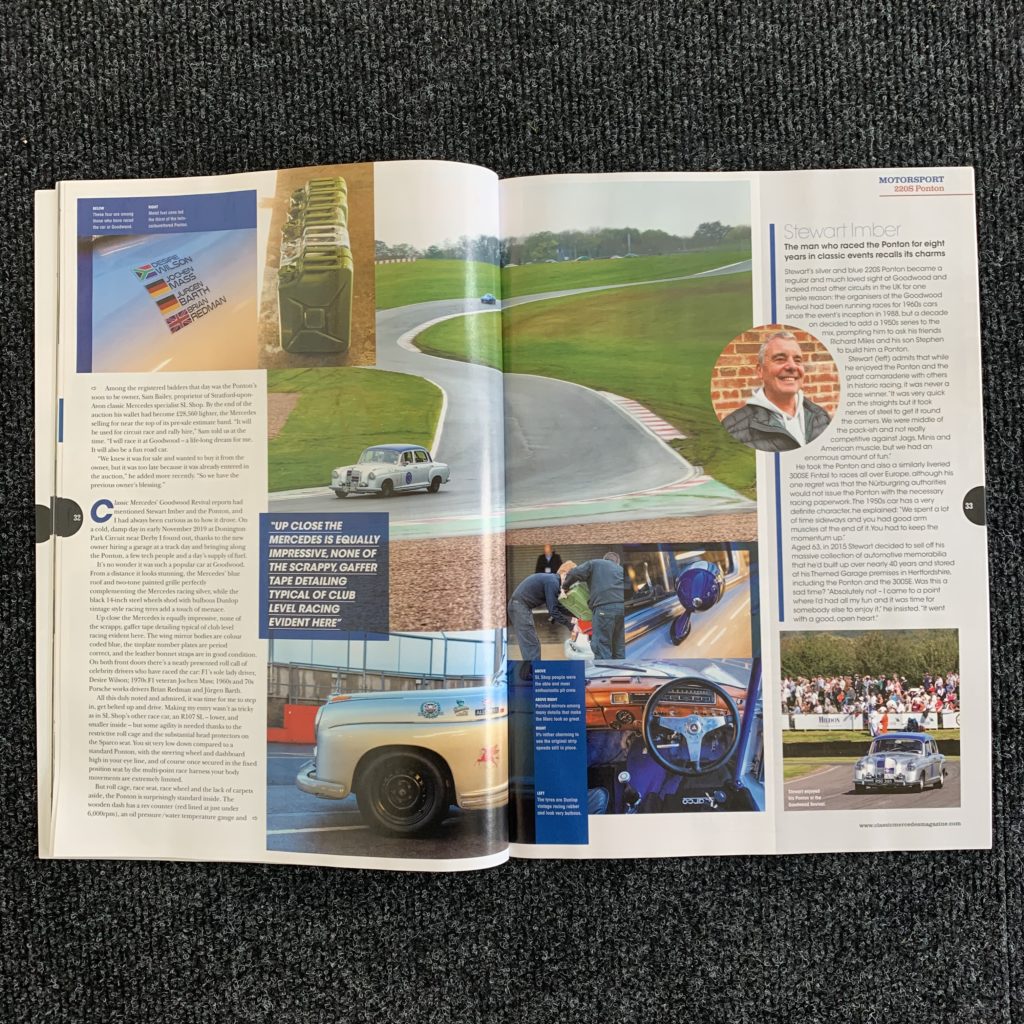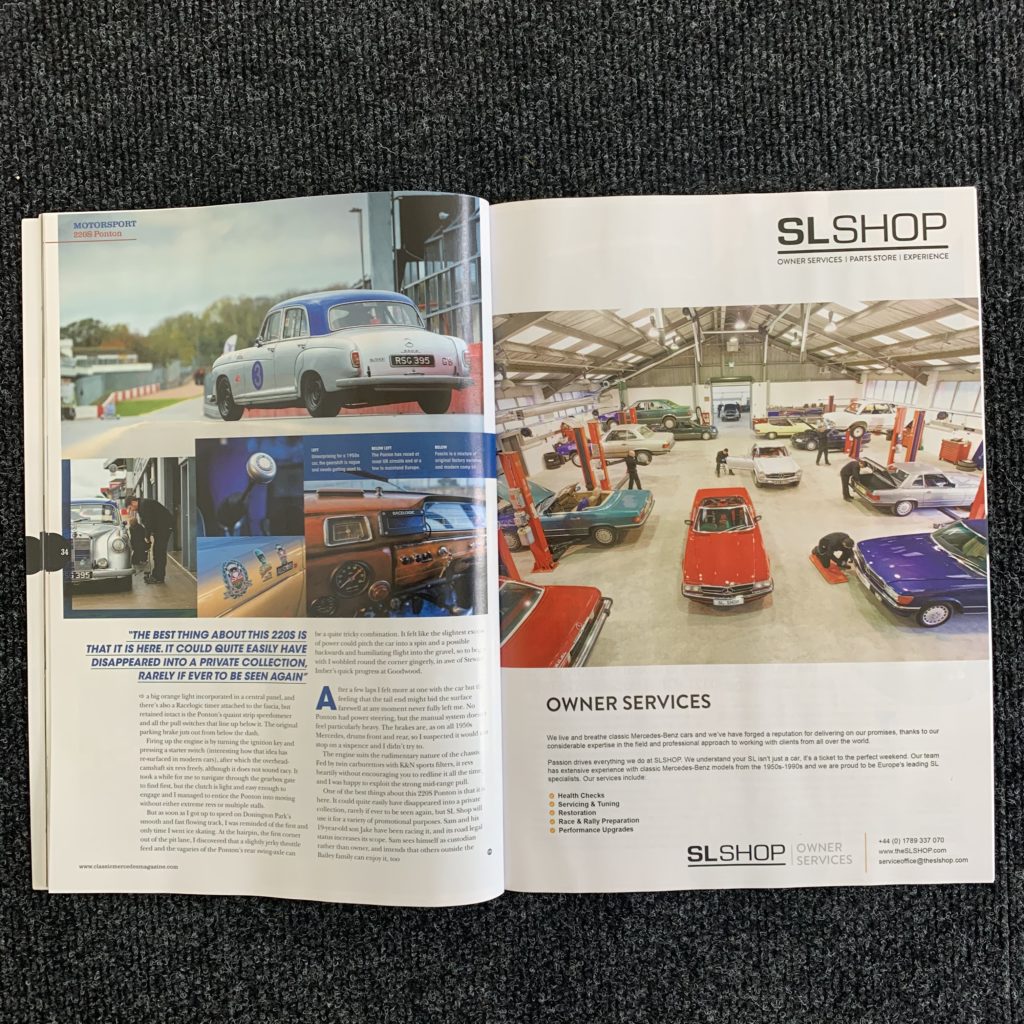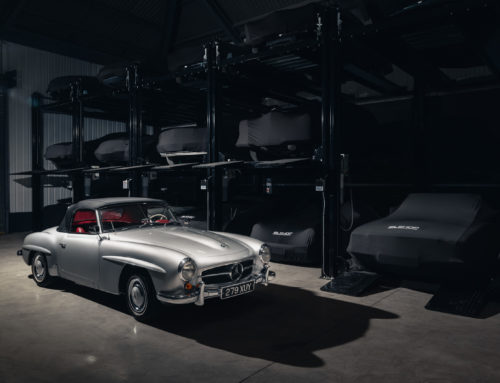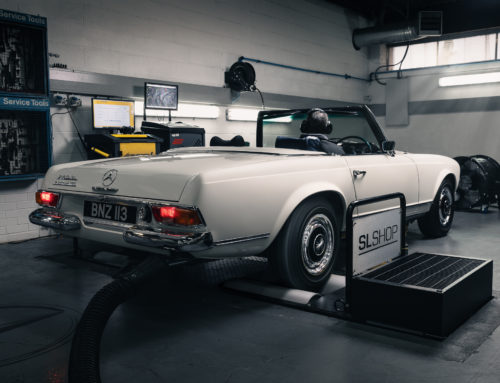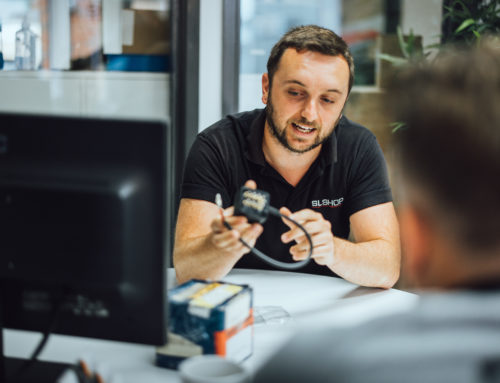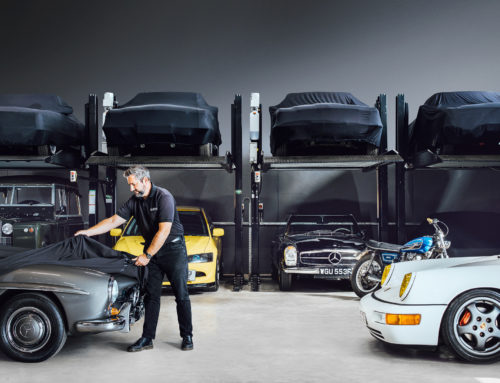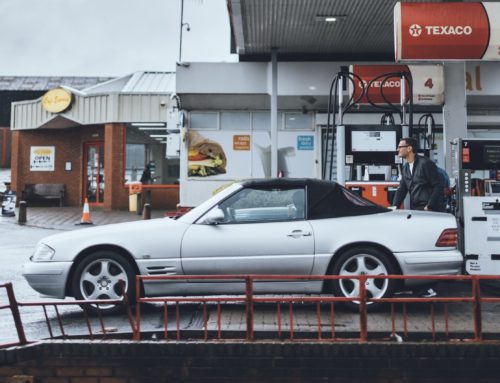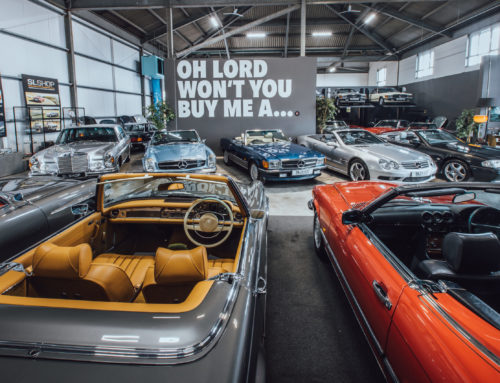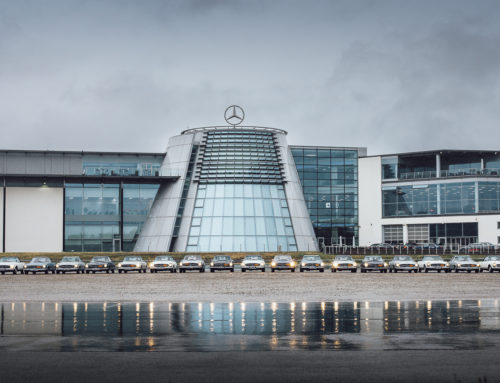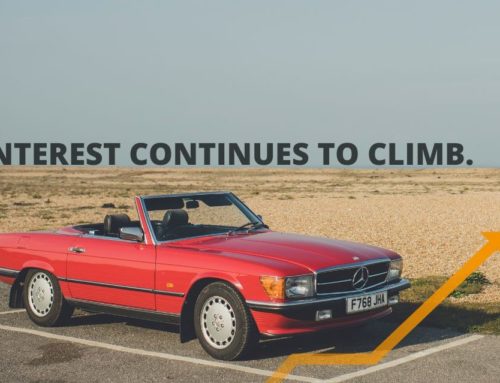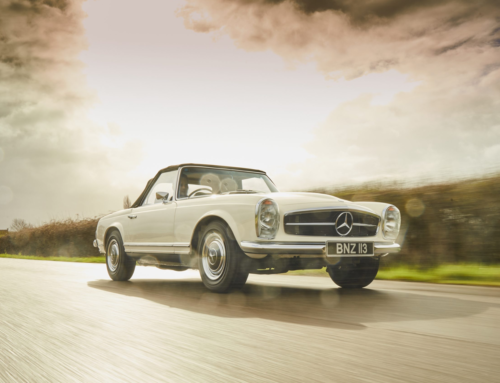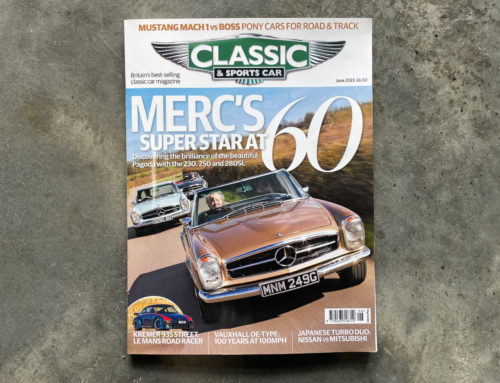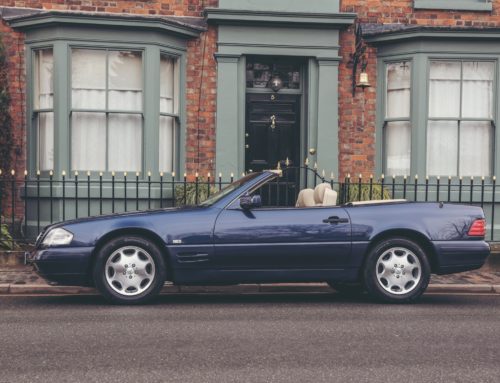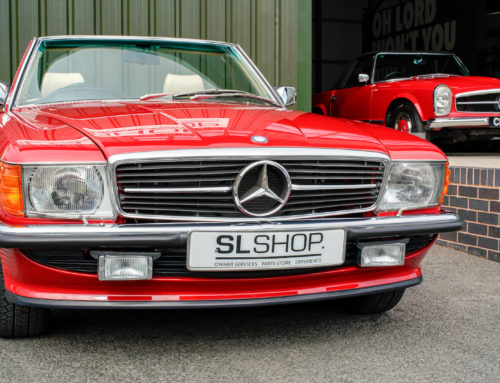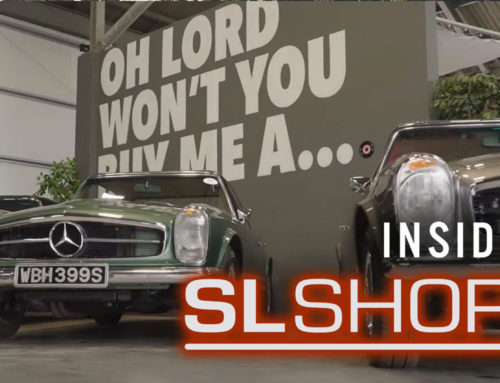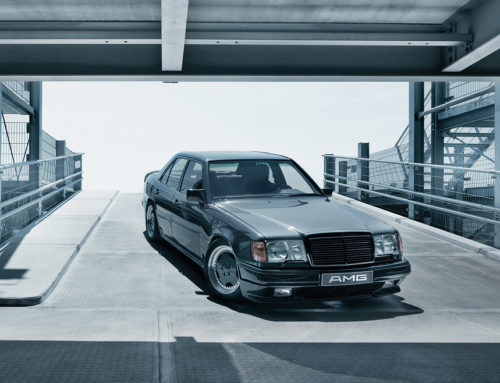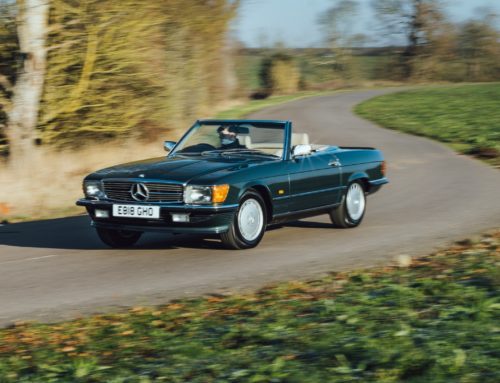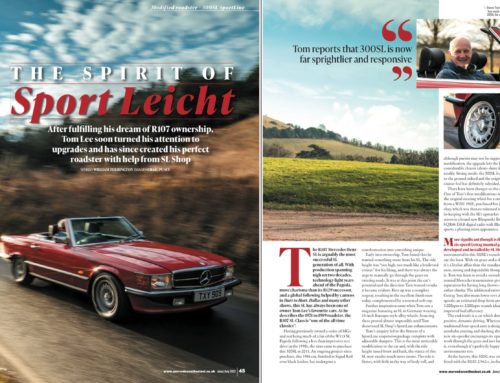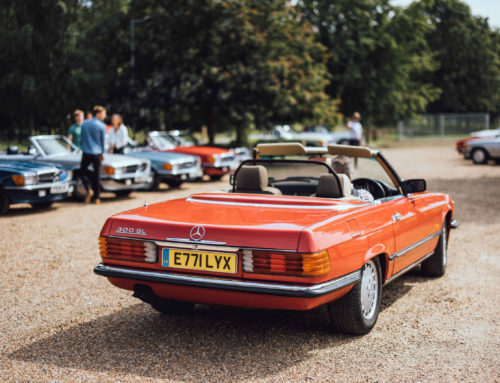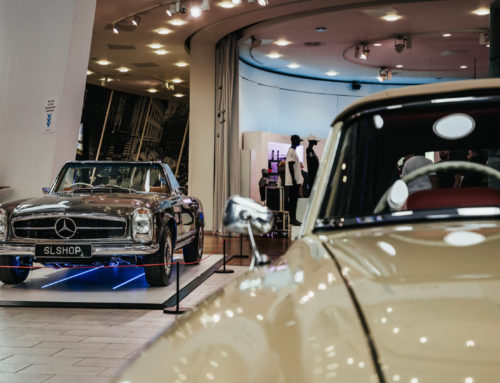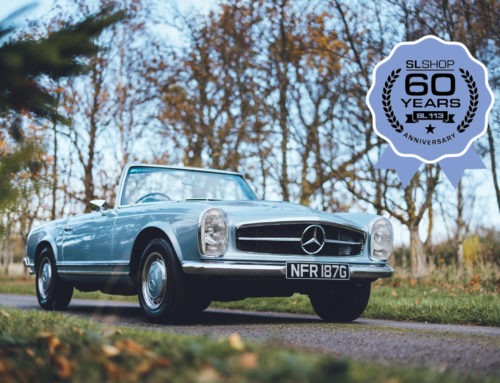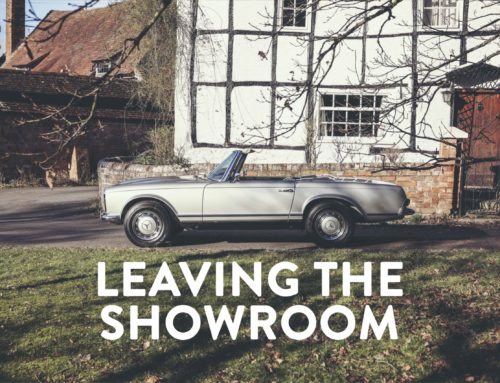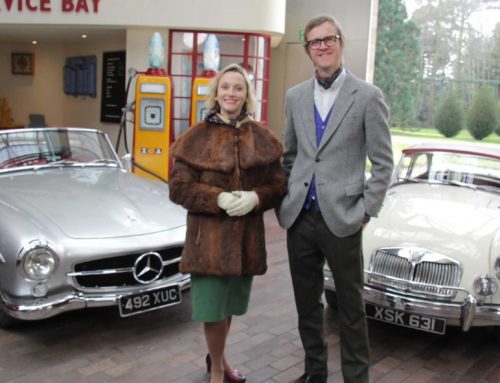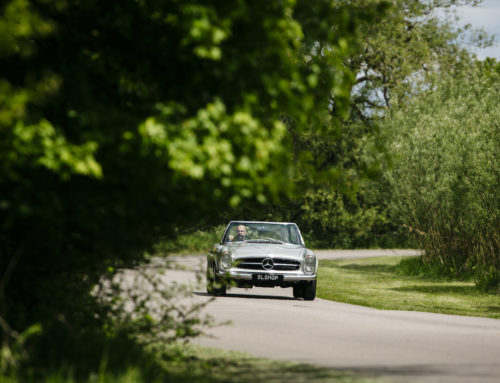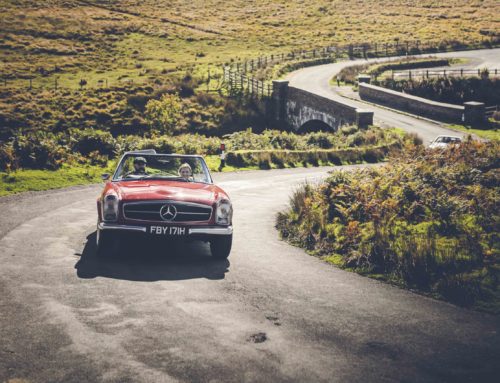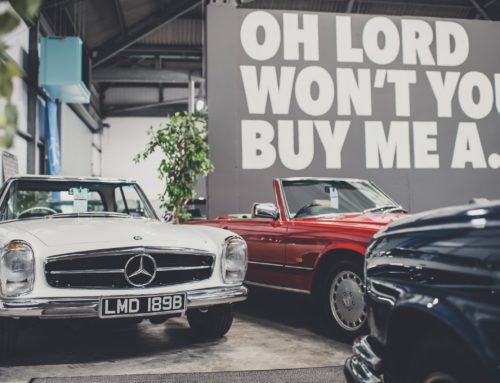Making history great
This 1957 220S was campaigned in classic racing for almost a decade before being sold off to a collector – but four years later it was unexpectedly brought out of retirement. David Sutherland explains why, and takes to the wheel.
Mention 1950s Mercedes-Benz motorsport and for most enthusiasts two images are conjured up: the lightweight, gullwing-doored 300SL scoring victory after victory in the long-distance international sports car races of 1952, and the crushing dominance of the Formula 1 W196 cars, plus their SLR sports car derivatives during the 1954 and 1955 seasons. But before and after there was another strand of Mercedes motorsport, the humble ‘Ponton’ its mainstay.
Mercedes’ motorsport boss, the legendary, indomitable Alfred Neubauer, had little interest in rallying, and indeed was openly disdainful of any other form of racing below the top level. But a number of privateers raced and rallied their own cars and they flew the flag for Stuttgart away from international events.
The name probably best remembered from this time is Walter Schock, an ex-Luftwaffe night fighter aircrew member, who began his rallying career by entering his own 220 Ponton in the 1954 Solitude Rally, an event consisting of a series of special stages that had been added to the existing circuit racing at Solitude Castle near Stuttgart. He and co-driver Rudolf Moll won the event, apparently to Schock’s great surprise, and by the time the same pairing participated in the 1955 Monte Carlo Rally, Mercedes-Benz was even helping them, by modifying the Ponton’s suspension.
At the end of the four-day event the Schock/Moll 220 was fifth placed. Later in the same year the duo won the Sestriere Rally in Italy, took second place in the Adriatica Rally in Yugoslavia, and fourth place in the Viking Rally in Norway, as well as returning for the 1955 Solitude Rally and finishing third in what was now a true long-distance event, of some 1,250 miles. The privateers ended the season runners-up in the European championship.
When Mercedes-Benz withdrew from F1 at the end of 1955, in the wake of the Le Mans tragedy, Neubauer resigned as motorsport manager to be replaced by Karl Kling. Whereas previously Mercedes’ competition focus had been to highlight its cars as engineering thoroughbreds, rallying emphasised regular production cars’ toughness and reliability. Hence funds began to be directed towards factory supported rallying, and after the six-cylinder Ponton was replaced by the similarly engine Fintail in 1959, Mercedes’ rallying became effectively a full works team.
The 220S seen here is a track rather than a rally car, but despite the lack of a specific historical reference it is a wonderful tribute to Pontons campaigned in those post-war years. The 1957 car was race readied in the 2000s for Stewart Imber, owner of Themed Garages in Hertfordshire and a lifelong car and automobilia collector, who enthusiastically raced it in historic events, including at the Goodwood Revival meeting in West Sussex for eight years from 2008. A number of racing greats have also been at its wheel at Goodwood.
It was Richard Miles of Tipton Garage in Sidmouth in Devon, a former Bradham F1 mechanic and then technical expert at tuner Downton Engineering, who built the car and also looked after it during its Goodwood years. It ran in the Historic Racing Drivers Club Touring Greats series, which permitted certain modifications while attempting to preserve period character. Hence the Ponton’s 2.2-litre engine was replaced by a 2.8 unit and mated to a limited-slip differential, but the interior, although fitted with a roll cage, Sparco race bucket seat and other safety items, retains many original factory fittings. The car’s immaculate appearance always made it a popular attraction at Goodwood.
In 2015 Stewart decided to wind down his classic activities and disposed of much of his inventory, including the 220S in early 2016. It was sold to a private collector and the natural assumption was that the Ponton’s days as a high-profile historic racer were over. Then the catalogue for Historic Auctioneers’ sale at Mercedes-Benz World in May 2019 appeared, with the familiar silver and blue, squatly suspended 220S, registration RSG 395, as lot 157. For medical reasons the owner was disposing of it.
Among the registered bidders that day was the Ponson’s soon to be owner, Sam Bailey, proprietor of Stratford-upon-Avon classic Mercedes specialist SL Shop. By the end of the auction his wallet had become £28,560 lighter, the Mercedes selling for near the top of its pre-sale estimate band. “It will be used for circuit race and rally hire,” Sam told us at the time. “I will race it at Goodwood – a life-long dram for me. It will also be a fun road car.
“We knew it was for sale and wanted to buy it from the owner, but it was too late because it was already entered in the auction,” he added more recently. “So, we have the previous owner’s blessing.”
Classic Mercedes’ Goodwood Revival reports had mentioned Stewart Imber and the Ponton, and I had always been curious as to how it drove. On a cold, damp day in early November 2019 at Donington Park Circuit near Derby I found out, thanks to the new owner hiring a garage at a track day and bringing along the Ponton, a few tech people and a day’s supply of fuel.
It’s no wonder it was such a popular car at Goodwood. From a distance it looks stunning, the Mercedes’ blue roof and two-tone painted grille perfectly complementing the Mercedes racing silver, while the black 14-inch street wheels shod with bulbous Dunlop vintage style racing tyres add a touch of menace.
Up-close the Mercedes is equally impressive, none of the scrappy, gaffer tape detailing typical of club level racing evident here. The wing mirror bodies are colour coded blue, the tinplate number plates are period correct, and the leather bonnet straps are in good condition. On both front doors there’s a neatly presented roll call of celebrity drivers who have raced the car: F1’s sole lady driver, Desire Wilson; 1970s F1 veteran Jochen Mass; 1960s and 70s Porsche works drivers Brian Redman and Jurgen Barth.
All this duly noted and admired, it was time for me to step in, get belted up and drive. Making my entry wasn’t as tricky as in SL Shop’s other race car, an R107SL – lower, and smaller inside – but some agility is needed thanks to the restrictive roll cage and the substantial head protectors on the Sparco seat. You sit very low down compared to a standard Ponton, with the steering wheel and dashboard high in your eye line, and of course once secured in the fixed position seat by the multi-point race harness your body movements are extremely limited.
But roll cage, race seat, race wheel and the lack of carpets aside, the Ponton is surprisingly standard inside. The wooden dash has a rev counter (red lined at just under 6,000rpm), an oil pressure/water temperature gauge and a big orange light incorporated in a central panel, and there’s also a Racelogic timer attached to the fascia, but retained intact is the Ponton’s quaint strip speedometer and all the pull switches that line up below it. The original parking brake juts out from below the dash.
Firing up the engine is by turning the ignition key and pressing a starter switch (interesting how that idea has re-surfaced in modern cars), after which the overhead camshaft six revs freely, although it does not sound racy. It took a while for me to navigate through the gearbox gate to find ‘first’, but the clutch is light and easy enough to engage and I managed to entice the Ponton into moving without either extreme revs or multiple stalls.
But as soon as I got up to speed on Donington Park’s smooth and fast-flowing track, I was reminded of the first and only time I went ice skating. At the hairpin, the first corner out of the pit lane, I discovered that a slightly jerky throttle feed and the vagaries of the Ponton’s rear swing-axle can be a quite tricky combination. It felt like the slightest excess of power cold pitch the car into a spin and a possible backwards and humiliating flight into the gravel, so to begin with I wobbled round the corner gingerly, in awe of Stewart Imber’s quick progress at Goodwood.
After a few laps I felt more at one with the car but the feeling that the tail end might bid the surface farewell at any moment never fully left me. No Ponton had power steering, but the manual system doesn’t feel particularly heavy. The brakes are, as on all 1950s Mercedes, drums front and rear, so I suspected it would not stop on a sixpence and I didn’t try to.
The engine suits the rudimentary nature of the chassis. Fed by twin carburettors with K&N sport filters, it revs heartily without encouraging you to redline it all the time and I was happy to exploit the strong mid-range pull.
One of the best things about this 20S Ponton is that it is here. It could quite easily have disappeared into a private collection, rarely if ever to be seen again, but SL Shop will use it for a variety of promotional purposes. Sam and his 19-year-old son Jake have been racing it, and its road legal status increases its scope. Sam sees himself as custodian rather than owner, and intends that others outside the Bailey family can enjoy it too.
Stewart Imber
The man who raced the Ponton for eight years in classic events recalls its charms.
Stewart’s silver and blue 220S Ponton became a regular and much-loved sight at Goodwood and indeed most other circuits in the UK for one simple reason: the organisers of the Goodwood Revival had been running races for 1960s cars since the event’s inception in 1988, but a decade on decided to add a 1950s series to the mix, prompting him to ask his friends Richard Miles and his son Stephen to build him a Ponton.
Stewart admits that while he enjoyed the Ponton and the great camaraderie with others in historic racing, it was never a race winner. “It was very quick on the straights but it took nerves of steel to get it round the corners. We were middle of the pack-ish and not really competitive against Jags, Minis and American muscle, but we had an enormous amount of fun.”
He took the Ponton and also a similarly liveried 300SE Fintail to races all over Europe, although his one regret was that the Nurburgring authorities would not issue the Ponton with the necessary racing paperwork. The 1950s car has a very definite character, he explained: “We spent a lot of time sideways and you had good arm muscles at the end of it. You had to keep the momentum up.”
Aged 63, in 2015 Stewart decided to sell off his massive collection of automotive memorabilia that he’d built up over nearly 40 years and stored at his Themed Garage premises in Hertfordshire, including the Ponton and the 300SE. Was this a sad time? “Absolutely not – I came to a point where I’d had all my fun and it was time for somebody else to enjoy it,” he insisted. “It went with a good, open heart.”
Share With Your Fellow Enthusiasts
Making history great
This 1957 220S was campaigned in classic racing for almost a decade before being sold off to a collector – but four years later it was unexpectedly brought out of retirement. David Sutherland explains why, and takes to the wheel.
Mention 1950s Mercedes-Benz motorsport and for most enthusiasts two images are conjured up: the lightweight, gullwing-doored 300SL scoring victory after victory in the long-distance international sports car races of 1952, and the crushing dominance of the Formula 1 W196 cars, plus their SLR sports car derivatives during the 1954 and 1955 seasons. But before and after there was another strand of Mercedes motorsport, the humble ‘Ponton’ its mainstay.
Mercedes’ motorsport boss, the legendary, indomitable Alfred Neubauer, had little interest in rallying, and indeed was openly disdainful of any other form of racing below the top level. But a number of privateers raced and rallied their own cars and they flew the flag for Stuttgart away from international events.
The name probably best remembered from this time is Walter Schock, an ex-Luftwaffe night fighter aircrew member, who began his rallying career by entering his own 220 Ponton in the 1954 Solitude Rally, an event consisting of a series of special stages that had been added to the existing circuit racing at Solitude Castle near Stuttgart. He and co-driver Rudolf Moll won the event, apparently to Schock’s great surprise, and by the time the same pairing participated in the 1955 Monte Carlo Rally, Mercedes-Benz was even helping them, by modifying the Ponton’s suspension.
At the end of the four-day event the Schock/Moll 220 was fifth placed. Later in the same year the duo won the Sestriere Rally in Italy, took second place in the Adriatica Rally in Yugoslavia, and fourth place in the Viking Rally in Norway, as well as returning for the 1955 Solitude Rally and finishing third in what was now a true long-distance event, of some 1,250 miles. The privateers ended the season runners-up in the European championship.
When Mercedes-Benz withdrew from F1 at the end of 1955, in the wake of the Le Mans tragedy, Neubauer resigned as motorsport manager to be replaced by Karl Kling. Whereas previously Mercedes’ competition focus had been to highlight its cars as engineering thoroughbreds, rallying emphasised regular production cars’ toughness and reliability. Hence funds began to be directed towards factory supported rallying, and after the six-cylinder Ponton was replaced by the similarly engine Fintail in 1959, Mercedes’ rallying became effectively a full works team.
The 220S seen here is a track rather than a rally car, but despite the lack of a specific historical reference it is a wonderful tribute to Pontons campaigned in those post-war years. The 1957 car was race readied in the 2000s for Stewart Imber, owner of Themed Garages in Hertfordshire and a lifelong car and automobilia collector, who enthusiastically raced it in historic events, including at the Goodwood Revival meeting in West Sussex for eight years from 2008. A number of racing greats have also been at its wheel at Goodwood.
It was Richard Miles of Tipton Garage in Sidmouth in Devon, a former Bradham F1 mechanic and then technical expert at tuner Downton Engineering, who built the car and also looked after it during its Goodwood years. It ran in the Historic Racing Drivers Club Touring Greats series, which permitted certain modifications while attempting to preserve period character. Hence the Ponton’s 2.2-litre engine was replaced by a 2.8 unit and mated to a limited-slip differential, but the interior, although fitted with a roll cage, Sparco race bucket seat and other safety items, retains many original factory fittings. The car’s immaculate appearance always made it a popular attraction at Goodwood.
In 2015 Stewart decided to wind down his classic activities and disposed of much of his inventory, including the 220S in early 2016. It was sold to a private collector and the natural assumption was that the Ponton’s days as a high-profile historic racer were over. Then the catalogue for Historic Auctioneers’ sale at Mercedes-Benz World in May 2019 appeared, with the familiar silver and blue, squatly suspended 220S, registration RSG 395, as lot 157. For medical reasons the owner was disposing of it.
Among the registered bidders that day was the Ponson’s soon to be owner, Sam Bailey, proprietor of Stratford-upon-Avon classic Mercedes specialist SL Shop. By the end of the auction his wallet had become £28,560 lighter, the Mercedes selling for near the top of its pre-sale estimate band. “It will be used for circuit race and rally hire,” Sam told us at the time. “I will race it at Goodwood – a life-long dram for me. It will also be a fun road car.
“We knew it was for sale and wanted to buy it from the owner, but it was too late because it was already entered in the auction,” he added more recently. “So, we have the previous owner’s blessing.”
Classic Mercedes’ Goodwood Revival reports had mentioned Stewart Imber and the Ponton, and I had always been curious as to how it drove. On a cold, damp day in early November 2019 at Donington Park Circuit near Derby I found out, thanks to the new owner hiring a garage at a track day and bringing along the Ponton, a few tech people and a day’s supply of fuel.
It’s no wonder it was such a popular car at Goodwood. From a distance it looks stunning, the Mercedes’ blue roof and two-tone painted grille perfectly complementing the Mercedes racing silver, while the black 14-inch street wheels shod with bulbous Dunlop vintage style racing tyres add a touch of menace.
Up-close the Mercedes is equally impressive, none of the scrappy, gaffer tape detailing typical of club level racing evident here. The wing mirror bodies are colour coded blue, the tinplate number plates are period correct, and the leather bonnet straps are in good condition. On both front doors there’s a neatly presented roll call of celebrity drivers who have raced the car: F1’s sole lady driver, Desire Wilson; 1970s F1 veteran Jochen Mass; 1960s and 70s Porsche works drivers Brian Redman and Jurgen Barth.
All this duly noted and admired, it was time for me to step in, get belted up and drive. Making my entry wasn’t as tricky as in SL Shop’s other race car, an R107SL – lower, and smaller inside – but some agility is needed thanks to the restrictive roll cage and the substantial head protectors on the Sparco seat. You sit very low down compared to a standard Ponton, with the steering wheel and dashboard high in your eye line, and of course once secured in the fixed position seat by the multi-point race harness your body movements are extremely limited.
But roll cage, race seat, race wheel and the lack of carpets aside, the Ponton is surprisingly standard inside. The wooden dash has a rev counter (red lined at just under 6,000rpm), an oil pressure/water temperature gauge and a big orange light incorporated in a central panel, and there’s also a Racelogic timer attached to the fascia, but retained intact is the Ponton’s quaint strip speedometer and all the pull switches that line up below it. The original parking brake juts out from below the dash.
Firing up the engine is by turning the ignition key and pressing a starter switch (interesting how that idea has re-surfaced in modern cars), after which the overhead camshaft six revs freely, although it does not sound racy. It took a while for me to navigate through the gearbox gate to find ‘first’, but the clutch is light and easy enough to engage and I managed to entice the Ponton into moving without either extreme revs or multiple stalls.
But as soon as I got up to speed on Donington Park’s smooth and fast-flowing track, I was reminded of the first and only time I went ice skating. At the hairpin, the first corner out of the pit lane, I discovered that a slightly jerky throttle feed and the vagaries of the Ponton’s rear swing-axle can be a quite tricky combination. It felt like the slightest excess of power cold pitch the car into a spin and a possible backwards and humiliating flight into the gravel, so to begin with I wobbled round the corner gingerly, in awe of Stewart Imber’s quick progress at Goodwood.
After a few laps I felt more at one with the car but the feeling that the tail end might bid the surface farewell at any moment never fully left me. No Ponton had power steering, but the manual system doesn’t feel particularly heavy. The brakes are, as on all 1950s Mercedes, drums front and rear, so I suspected it would not stop on a sixpence and I didn’t try to.
The engine suits the rudimentary nature of the chassis. Fed by twin carburettors with K&N sport filters, it revs heartily without encouraging you to redline it all the time and I was happy to exploit the strong mid-range pull.
One of the best things about this 20S Ponton is that it is here. It could quite easily have disappeared into a private collection, rarely if ever to be seen again, but SL Shop will use it for a variety of promotional purposes. Sam and his 19-year-old son Jake have been racing it, and its road legal status increases its scope. Sam sees himself as custodian rather than owner, and intends that others outside the Bailey family can enjoy it too.
Stewart Imber
The man who raced the Ponton for eight years in classic events recalls its charms.
Stewart’s silver and blue 220S Ponton became a regular and much-loved sight at Goodwood and indeed most other circuits in the UK for one simple reason: the organisers of the Goodwood Revival had been running races for 1960s cars since the event’s inception in 1988, but a decade on decided to add a 1950s series to the mix, prompting him to ask his friends Richard Miles and his son Stephen to build him a Ponton.
Stewart admits that while he enjoyed the Ponton and the great camaraderie with others in historic racing, it was never a race winner. “It was very quick on the straights but it took nerves of steel to get it round the corners. We were middle of the pack-ish and not really competitive against Jags, Minis and American muscle, but we had an enormous amount of fun.”
He took the Ponton and also a similarly liveried 300SE Fintail to races all over Europe, although his one regret was that the Nurburgring authorities would not issue the Ponton with the necessary racing paperwork. The 1950s car has a very definite character, he explained: “We spent a lot of time sideways and you had good arm muscles at the end of it. You had to keep the momentum up.”
Aged 63, in 2015 Stewart decided to sell off his massive collection of automotive memorabilia that he’d built up over nearly 40 years and stored at his Themed Garage premises in Hertfordshire, including the Ponton and the 300SE. Was this a sad time? “Absolutely not – I came to a point where I’d had all my fun and it was time for somebody else to enjoy it,” he insisted. “It went with a good, open heart.”
Share With Your Fellow Enthusiasts
More from Journal
CARE
THE ULTIMATE CERTIFIED SERVICING INVESTMENT PLAN
Your ownership journey matters to us, which is why we have created a simple certified servicing investment plan, tailored to your individual needs and aspirations.
Start investing today and our dedicated CARE team will work with you to increase the value and enjoyment you receive from your vehicle.

STAY IN TUNE WITH SLSHOP MOMENTS
As part of SLSHOP’s community of enthusiasts, you’ll be the first to hear about events and tours, key product offers, exciting stories from owners around the world and of course… our latest additions to the showroom. So, be the first to know and you might just sneak a car on your driveway or take your car’s condition to new heights with our exclusive replacement parts.
Or, visit SLSHOP Journal
